
Bozrah Congregational Church and Parsonage is a historic church and parsonage at 17 and 23 Bozrah Street in Bozrah, Connecticut. The church, built in 1843, is a well-preserved example of churches transitional between Federal period meeting house architecture and 19th-century Greek Revival church architecture. The property was added to the National Register of Historic Places in 1991.
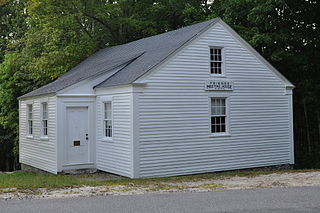
Friends Meetinghouse is a historic Quaker meeting house on Quaker Ridge Road in Casco, Maine. Built in 1814, it is the oldest surviving Quaker meeting house in the state. It was listed on the National Register of Historic Places in 1975.

The Porter Old Meetinghouse is a historic meeting house on Old Meetinghouse Road in Porter, Maine, United States. Built in 1818-24, it is a well-preserved example of a meeting house in rural Maine, serving as a center of local religious and civic activities. The building was listed on the National Register of Historic Places in 1973.
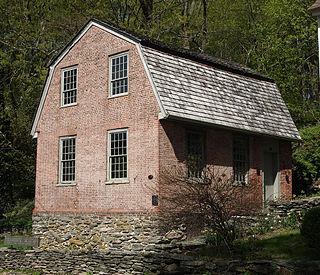
The East District School is a historic school building at 365 Washington Street in Norwich, Connecticut. Built in 1798, it is significant as a rare and well-preserved 18th-century schoolhouse, and as the location of an evening school for adults established by Consider Sterry, author of an early guide to practical navigation. The school was listed on the National Register of Historic Places in 1970, and is a contributing property to the Norwichtown Historic District.

The War Office, also once known as the Capt. Joseph Trumble Store and Office, is a historic commercial building on the Lebanon Green in Lebanon, Connecticut, built about 1732 as a commercial building. It is most significant as the place from which Governor Jonathan Trumbull conducted military business during the American Revolutionary War. It is now part of the museum property managed by the Connecticut Society of the Sons of the American Revolution that also includes the Trumbull House and the Wadsworth Stables. The building was listed on the National Register of Historic Places in 1970.
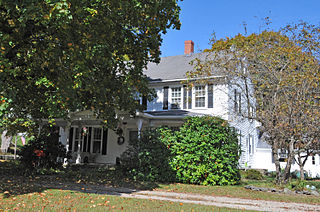
Ashlawn, also called the Joshua Perkins House, is a two-story, central-hall frame farmhouse dating from the 18th century in Hanover, Connecticut. The house's namesake is its first owner, Joshua Perkins, a farmer and son of the prominent Captain Matthew Perkins, a farmer and founding member of the Hanover Society. Ashlawn's main house has a five-bay front facade with pilasters supporting broken-base pediments. The inside has well-documented woodwork for its moldings and wainscotting. The house has integrated an older structure, likely a central-chimney structure built in the second quarter of the 18th century, as an ell.

847 North Main Street in West Hartford, Connecticut, is one of the town's few surviving 18th-century houses. Dating to the mid-18th century, it is a well-preserved example of vernacular Georgian architecture, with a modest entrance surround. The house was listed on the National Register of Historic Places on September 10, 1986.

The Acors Barns House is located at 68 Federal Street at the corner of Meridian Street in New London, Connecticut. Barns was a wealthy merchant in the whaling industry whose company became one of the largest whaling firms in the city. He managed to avoid the collapse of whaling by investing elsewhere; he was the founder of the Bank of Commerce in 1852, and his son and grandson succeeded him as president.

The Edward Salyer House is located on South Middletown Road in Pearl River, New York, United States. It is a wood frame house built in the 1760s.

Bennington No. 4, also known as the Bennington School, is a one-room schoolhouse near Waterloo, Iowa. Built in 1911, it served four sections which provided as many as thirty or more students for first through eighth grades. Students in higher grades attended Waterloo East High School. The school served the predominantly German-American community until 1955 when it was closed. While it was open, the school also served as a community center. In 1958 the vacant building was sold to the local Sage family, whose members had attended and taught at the school. Restoration work took place through the 1990s.
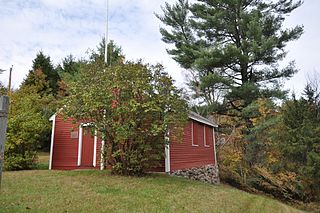
The Little Red School House, or the District No. 7 Schoolhouse, is a one-room schoolhouse on New Hampshire Route 10, south of downtown Newport, New Hampshire. Built in 1835, it is one of the state's few surviving pre-1850 district schoolhouses, and one of the least-altered of that group. It served the city as a school until 1891, and was acquired in 1951 by the local chapter of the Daughters of the American Revolution. It is open as a museum during the summer months. The building was listed on the National Register of Historic Places in 1980.
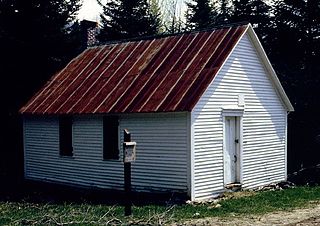
The District No. 1 Schoolhouse is a historic one-room schoolhouse on Somerset Road in Somerset, Vermont, United States. Built about 1850, it is the only known entirely unaltered district schoolhouse in the state, and is probably the only surviving municipal building from the tiny community, which was disincorporated in 1937. The building was listed on the National Register of Historic Places in 1992.

The Simeon Smith House is a historic house on Main Road in West Haven, Vermont. Built in 1798–1800 to a design by William Sprat, a prominent housewright from Litchfield, Connecticut, it is a fine example of period Federal architecture. It was built for Simeon Smith, a wealthy businessman who moved here from Connecticut. The house was listed on the National Register of Historic Places in 1983.
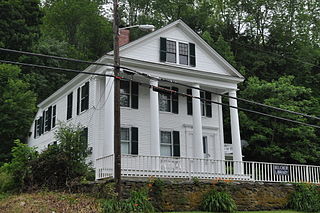
The Belcher Memorial Library is a small public library serving the village of Gaysville in Stockbridge, Vermont, United States. It is located in the Daniel Gay House, an 1835 Greek Revival house built by Daniel Gay, a mill owner and namesake of the community. The building, one of the few to survive the 1927 flooding that destroyed most of the village, was listed on the National Register of Historic Places in 1978.

The Brock Hill Schoolhouse is a historic one-room schoolhouse on North Road in rural Newbury, Vermont. Built in 1850, it is a well-preserved example of a mid-19th century schoolhouse with Greek Revival styling. It was listed on the National Register of Historic Places in 2003.

The Henry Magill House is a historic house at 390 Palisado Avenue in Windsor, Connecticut. Built in 1861, it is a well-preserved and locally rare example of Second Empire architecture executed in brick. It was listed on the National Register of Historic Places in 1988.

The David Chapman Farmstead is a historic house at 128 Stoddards Wharf Road in Ledyard, Connecticut. Built about 1744, it is a well-preserved example of a vernacular rural farmhouse of the period, built by a descendant of one of Ledyard's early settlers. It was listed on the National Register of Historic Places in 1992.

The Bell-Spalding House, also known as the Tuomy House, is a single-family home located at 2117 Washtenaw Avenue in Ann Arbor, Michigan. It was listed on the National Register of Historic Places in 1990.

The John Hoadley House is a historic house at 213 Leete's Island Road in Branford, Connecticut. Built about 1810, it is a well-preserved example of late colonial architecture. It was listed on the National Register of Historic Places in 1988.

The Richard Mansfield House is a historic house at 35 Jewett Street in Ansonia, Connecticut. Built at the turn of the 17th-century, it is one of the community's oldest surviving buildings, and is noted for its association with a prominent early Episcopal minister. It was listed on the National Register of Historic Places in 1971.






















